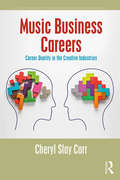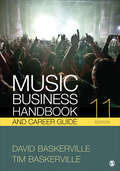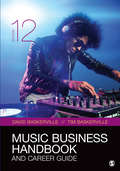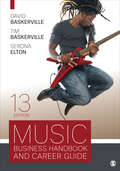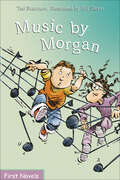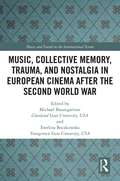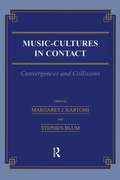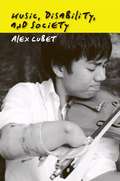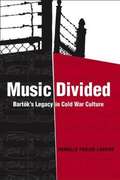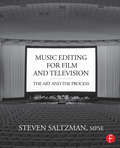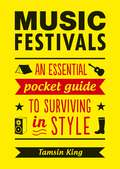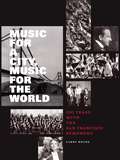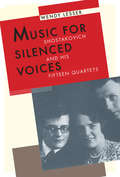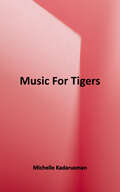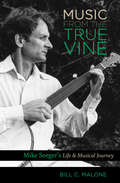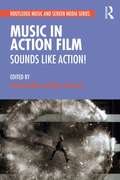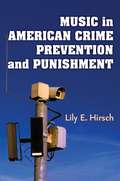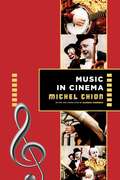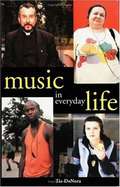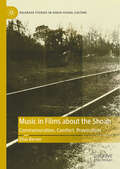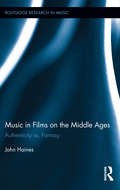- Table View
- List View
Music Business Careers: Career Duality in the Creative Industries (Routledge Research in Creative and Cultural Industries Management)
by Cheryl Slay CarrThe music industry offers the opportunity to pursue a career as either a creative (artist, producer, songwriter, etc.) or as a music business "logician" (artist manager, agent, entertainment attorney, venue manager, etc.). Though both vocational paths are integral to the industry’s success, the work of calling songs into existence or entertaining an audience differs from the administrative aspects of the business, such as operating an entertainment company. And while the daily activities of creatives may differ from those of the music business logician, the music industry careerist may sense a call to Career Duality, to work on both sides of the industry as a Career Dualist, a concept this book introduces, defines, and explores in the context of the music industry. This new volume speaks to the dilemma experienced by those struggling with career decisions involving whether to work in the industry using their analytical abilities, or to work as a creative, or to do both. The potential financial challenges encountered in working in the industry as an emerging artist may necessitate maintaining a second and simultaneous occupation (possibly outside the industry) that offers economic survival. However, this is not Career Duality. Likewise, attending to the business affairs that impact all creatives is not Career Duality. Rather, Career Duality involves the deliberate pursuit of a dual career as both a music industry creative and music business logician, which is stimulated by the drive to express dual proclivities that are simultaneously artistic and analytical. By offering a Career Duality model and other constructs, examining research on careers, calling, authenticity and related concepts, and providing profiles of music industry dualists, this book takes readers on a journey of self-exploration and offers insights and recommendations for charting an authentic career path. This is a practical examination for not only music industry professionals and the entertainment industry, but for individuals interested in expressing both the analytical and artistic self in the context of career.
Music Business Handbook and Career Guide
by David Baskerville Timothy BaskervilleThis powerhouse best-selling text remains the most comprehensive, up-to-date guide to the music industry. The breadth of coverage that Music Business Handbook and Career Guide, Eleventh Edition offers surpasses any other resource available. Readers new to the music business and seasoned professionals alike will find David Baskerville and Tim Baskerville’s handbook an indispensable resource, regardless of their specialty within the music field. This text is ideal for introductory courses such as Introduction to the Music Business, Music and Media, and Music Business Foundations as well as more specialized courses such as the record industry, music careers, artist management, and more. The fully updated Eleventh Edition includes coverage of key topics such as copyright, licensing, songwriting, concert venues, and the entrepreneurial musician. Uniquely, it provides career-planning insights on dozens of job categories in the diverse music industry.
Music Business Handbook and Career Guide
by David Baskerville Timothy BaskervilleThis powerhouse best-selling text remains the most comprehensive, up-to-date guide to the music industry. The breadth of coverage that Music Business Handbook and Career Guide, Eleventh Edition offers surpasses any other resource available. Readers new to the music business and seasoned professionals alike will find David Baskerville and Tim Baskerville’s handbook an indispensable resource, regardless of their specialty within the music field. This text is ideal for introductory courses such as Introduction to the Music Business, Music and Media, and Music Business Foundations as well as more specialized courses such as the record industry, music careers, artist management, and more. The fully updated Eleventh Edition includes coverage of key topics such as copyright, licensing, songwriting, concert venues, and the entrepreneurial musician. Uniquely, it provides career-planning insights on dozens of job categories in the diverse music industry.
Music Business Handbook and Career Guide
by David Baskerville Timothy BaskervilleThe Twelfth Edition of this powerhouse best-selling text maintains its tradition as the most comprehensive, up-to-date guide to the music industry in all of its diversity. Readers new to the music business and seasoned professionals alike will find David Baskerville and Tim Baskerville’s handbook the go-to source, regardless of their specialty within the music field. Music Business Handbook and Career Guide is ideal for introductory courses such as Introduction to the Music Business, Music and Media, and other survey courses as well as more specialized courses such as the record industry, music careers, artist management, and more. The fully updated Twelfth Edition includes a comprehensive discussion of the streaming revolution and its impact on all parts of the value chain, including composers, performing artists, publishers, and labels. The book also analyzes shifts in the competing platforms of consumption ranging from fast-shrinking physical formats and broadcasting to downloads and subscription services. This edition offers more vignettes than ever, illustrating how individuals in different industry roles advanced their careers, as well as how they’ve adjusted to the intertwining influences of technology, law, and culture.
Music Business Handbook and Career Guide
by David Baskerville Timothy BaskervilleThe Twelfth Edition of this powerhouse best-selling text maintains its tradition as the most comprehensive, up-to-date guide to the music industry in all of its diversity. Readers new to the music business and seasoned professionals alike will find David Baskerville and Tim Baskerville’s handbook the go-to source, regardless of their specialty within the music field. Music Business Handbook and Career Guide is ideal for introductory courses such as Introduction to the Music Business, Music and Media, and other survey courses as well as more specialized courses such as the record industry, music careers, artist management, and more. The fully updated Twelfth Edition includes a comprehensive discussion of the streaming revolution and its impact on all parts of the value chain, including composers, performing artists, publishers, and labels. The book also analyzes shifts in the competing platforms of consumption ranging from fast-shrinking physical formats and broadcasting to downloads and subscription services. This edition offers more vignettes than ever, illustrating how individuals in different industry roles advanced their careers, as well as how they’ve adjusted to the intertwining influences of technology, law, and culture.
Music Business Handbook and Career Guide
by David Baskerville Timothy Baskerville Serona EltonThe Thirteenth Edition of this powerhouse best-selling text maintains its tradition as the most comprehensive, up-to-date guide to the music industry in all of its diversity. Readers new to the music business and seasoned professionals alike will find David Baskerville, Tim Baskerville, and Serona Elton′s handbook the go-to source, regardless of their specialty within the music field. Music Business Handbook and Career Guide is ideal for introductory courses such as Introduction to the Music Business, Music and Media, and other survey courses as well as more specialized courses such as the Record Industry, Music Careers, Artist Management, and more. The fully updated Thirteenth Edition includes a comprehensive discussion of the streaming revolution, where this predominant form of music consumption stands today and is heading in the future. Rapid changes in music licensingare addressed and how they impact creators, musical work performance licensing, compulsory and negotiated mechanicals, and sound recording licenses. The new edition also analyzes the changing picture of music video and shows how music video has been upended by on-demand streaming. Lastly, there is all-new coverage of COVID-19and how the concert industry has been impacted as well as digital advances that have been made.
Music Business Handbook and Career Guide
by David Baskerville Timothy Baskerville Serona EltonThe Thirteenth Edition of this powerhouse best-selling text maintains its tradition as the most comprehensive, up-to-date guide to the music industry in all of its diversity. Readers new to the music business and seasoned professionals alike will find David Baskerville, Tim Baskerville, and Serona Elton′s handbook the go-to source, regardless of their specialty within the music field. Music Business Handbook and Career Guide is ideal for introductory courses such as Introduction to the Music Business, Music and Media, and other survey courses as well as more specialized courses such as the Record Industry, Music Careers, Artist Management, and more. The fully updated Thirteenth Edition includes a comprehensive discussion of the streaming revolution, where this predominant form of music consumption stands today and is heading in the future. Rapid changes in music licensingare addressed and how they impact creators, musical work performance licensing, compulsory and negotiated mechanicals, and sound recording licenses. The new edition also analyzes the changing picture of music video and shows how music video has been upended by on-demand streaming. Lastly, there is all-new coverage of COVID-19and how the concert industry has been impacted as well as digital advances that have been made.
Music By Morgan (Formac First Novels)
by Ted StauntonMorgan is not pleased when his parents sign him up to play floor hockey at the community center; he stinks at hockey and it's no fun. So when Aldeen Hummel, the Godzilla of Grade Three and a good hockey player, is unhappily signed up for piano lessons, Morgan crafts a plan to trade places.
Music, Collective Memory, Trauma and Nostalgia in European Cinema after the Second World War (Music and Sound on the International Screen)
by Michael Baumgartner Ewelina BoczkowskaIn the wake of World War II, the arts and culture of Europe became a site where the devastating events of the 20th century were remembered and understood. Exploring one of the most integral elements of the cinematic experience—music—the essays in this volume consider the numerous ways in which post-war European cinema dealt with memory, trauma and nostalgia, showing how the music of these films shaped the representation of the past. The contributors consider films from the United Kingdom, Poland, the Soviet Union, France, Italy, Germany, and the Netherlands, providing a diverse and well-rounded understanding of film music in the context of historical memory. Memory is often underrepresented within scholarly musical studies, with most of these applications found in the disciplines of ethnomusicology, popular music studies, music cognition, and psychology and music therapy. Likewise, trauma has mainly been studied in relation to music in only a few historical contexts, while nostalgia has attracted even less academic attention. In three parts, this volume addresses each area of study as it relates to the music of European cinema from 1945 to 1989, applying an interdisciplinary approach to investigate how films use music to negotiate the precarious relationships we maintain with the past. Music, Collective Memory, Trauma and Nostalgia in European Cinema after the Second World War offers compelling arguments as to what makes music such a powerful medium for memory, trauma and nostalgia.
Music \= Cultures in Contact: Convergences and Collisions (Musicology #16)
by Margaret J. Kartomi Stephen BlumFirst Published in 1995. Routledge is an imprint of Taylor & Francis, an informa company.
Music, Disability, and Society
by Alex LubetMusical talent in Western culture is regarded as an extraordinary combination of technical proficiency and interpretative sensitivity. In Music, Disability, and Society, Alex Lubet challenges the rigid view of technical skill and writes about music in relation to disability studies. He addresses the ways in which people with disabilities are denied the opportunity to participate in music. Elaborating on the theory of "social confluence," Lubet provides a variety of encounters between disability and music to observe radical transformations of identity. Considering hand-injured and one-handed pianists; the impairments of jazz luminaries Django Reinhardt, Horace Parlan, and "Little" Jimmy Scott; and the "Blind Orchestra" of Cairo, he shows how the cultural world of classical music contrasts sharply with that of jazz and how musicality itself is regarded a disability in some religious contexts. Music, Disability, and Society also explains how language difference can become a disability for Asian students in American schools of music, limiting their education and careers. Lubet offers pungent criticism of the biases in music education and the music profession, going so far as to say that culture disables some performers by adhering to rigid notions of what a musician must look like, how music must be played, who may play it, and what (if any) is the legitimate place of music in society. In Music, Disability, and Society, he convincingly argues that where music is concerned, disability is a matter of culture, not physical impairment.
Music Divided: Bartok's Legacy in Cold War Culture
by Danielle Fosler-LussierMusic Divided explores how political pressures affected musical life on both sides of the Iron Curtain during the early years of the cold war. In this groundbreaking study, Danielle Fosler-Lussier illuminates the pervasive political anxieties of the era through particular attention to artistic, music-theoretical, and propagandistic responses to the music of Hungary's most renowned twentieth-century composer, Bela Bartok. She shows how a tense period of political transition plagued Bartok's music and imperiled those who took a stand on its aesthetic value in the emerging socialist state. Her fascinating investigation of Bartok's reception outside of Hungary demonstrates that Western composers, too, formulated their ideas about musical style under the influence of ever-escalating cold war tensions.
Music Editing for Film and Television: The Art and the Process
by Steven SaltzmanMaking music for the movies is a complicated, involved, and challenging process. Music Editing for Film and Television covers the practical skills needed to successfully hone your craft. Through an overview of the music editing process, this book will equip you with detailed techniques to solve musical problems encountered during editing. An abundance of interviews with well-known professionals provide a wide range of perspectives on music editing for film, while special features address an array of projects, from a low-budget documentary, to a Hollywood blockbuster, to indie projects.
Music Festivals: An Essential Pocket Guide to Surviving in Style
by Tamsin KingFestivals come in every shape and size, but they are all a wonderful opportunity to have an awesome party! This guide is packed with tips to help you make the most of your festival experience, whether it’s at a sprawling tent city or a small but perfectly curated boutique festival.
Music Festivals: An Essential Pocket Guide to Surviving in Style
by Tamsin KingFestivals come in every shape and size, but they are all a wonderful opportunity to have an awesome party! This guide is packed with tips to help you make the most of your festival experience, whether it’s at a sprawling tent city or a small but perfectly curated boutique festival.
Music for a City Music for the World
by Larry RotheIn Music for a City, Music for the World, Larry Rothe shares how the San Francisco Bay Area's love of music, rooted in the Gold Rush, gave birth to a Grammy-winning and internationally acclaimed orchestra. Released in time for the San Francisco Symphony's celebration of its 100th anniversary, this definitive history replete with hundreds of archival photos and images gives readers a behind-the-scenes glimpse into one of the world's foremost orchestras and, in so doing, illuminates the cultural life of a city.
Music for Silenced Voices: Shostakovich and His Fifteen Quartets
by Wendy LesserMost previous books about Dmitri Shostakovich have focused on either his symphonies and operas, or his relationship to the regime under which he lived, or both, since these large-scale works were the ones that attracted the interest and sometimes the condemnation of the Soviet authorities. Music for Silenced Voiceslooks at Shostakovich through the back door, as it were, of his fifteen quartets, the works which his widow characterized as a "diary, the story of his soul. " The silences and the voices were of many kinds, including the political silencing of adventurous writers, artists, and musicians during the Stalin era; the lost voices of Shostakovich's operas (a form he abandoned just before turning to string quartets); and the death-silenced voices of his close friends, to whom he dedicated many of these chamber works. Wendy Lesser has constructed a fascinating narrative in which the fifteen quartets, considered one at a time in chronological order, lead the reader through the personal, political, and professional events that shaped Shostakovich's singular, emblematic twentieth-century life. Weaving together interviews with the composer's friends, family, and colleagues, as well as conversations with present-day musicians who have played the quartets, Lesser sheds new light on the man and the musician. One of the very few books about Shostakovich that is aimed at a general rather than an academic audience,Music for Silenced Voicesis a pleasure to read; at the same time, it is rigorously faithful to the known facts in this notoriously complicated life. It will fill readers with the desire to hear the quartets, which are among the most compelling and emotionally powerful monuments of the past century's music.
Music for Tigers
by Michelle Kadarusman“Middle-school student Louisa wants to spend the summer practicing violin for a place in the youth symphony, but is instead sent to the Tasmanian rain forest camp of her Australian relatives. There she learns that her family secretly protects the last of the supposedly extinct Tasmanian tigers. When an encroaching mining operation threatens the hidden sanctuary, Louisa realizes her music can help” - Provided by publisher.
Music from the True Vine: Mike Seeger's Life and Musical Journey
by Bill C. MaloneA musician, documentarian, scholar, and one of the founding members of the influential folk revival group New Lost City Ramblers, Mike Seeger (1933-2009) spent more than fifty years collecting, performing, and commemorating the culture and folk music of white and black southerners, which he called "music from the true vine. " In this fascinating biography, Bill Malone explores the life and musical contributions of folk artist Seeger, son of musicologists Charles and Ruth Crawford Seeger and brother of folksingers Pete and Peggy Seeger. Malone argues that Seeger, while not as well known as his brother, may be more important to the history of American music through his work in identifying and giving voice to the people from whom the folk revival borrowed its songs. Seeger recorded and produced over forty albums, including the work of artists such as Libba Cotton, Tommy Jarrell, Dock Boggs, and Maybelle Carter. In 1958, with an ambition to recreate the southern string bands of the twenties, he formed the New Lost City Ramblers, helping to inspire the urban folk revival of the sixties. Music from the True Vinepresents Seeger as a gatekeeper of American roots music and culture, showing why generations of musicians and fans of traditional music regard him as a mentor and an inspiration.
Music in Action Film: Sounds Like Action!
by James Buhler Mark DurrandMusic in Action Film is the first volume to address the central role of music and sound in action film—arguably the most dominant form of commercial cinema today. Bringing together 15 essays by established and emerging scholars, the book encompasses both Hollywood blockbusters and international films, from classic works such as The Seven Samurai to contemporary superhero franchises. The contributors consider action both as genre and as a mode of cinematic expression, in chapters on evolving musical conventions; politics, representation, and identity; musical affect and agency; the functional role of music and sound design in action film; and production technologies. Breaking new critical ground yet highly accessible, this book will be of interest to students and scholars of music and film studies.
Music in American Crime Prevention and Punishment
by Hirsch Lily E.Although the use of music for extramusical purposes has been a part of American culture for some time, the phenomenon remained largely unknown to the general public until revelations became widespread of startling military practices during the second Iraq War. In Music in American Crime Prevention and Punishment, Lily E. Hirsch explores the related terrain at the intersection of music and law, demonstrating the ways in which music has become a tool of law enforcement and justice through: police and community leaders’ use of classical music in crime deterrence and punishment; the use of rap lyrics as prosecutorial evidence; allegations of music as incitement to violence; and the role of music in U. S. prisons and in detention centers in Guantanamo, Iraq, and Afghanistan. In the course of her study, Hirsch asks several questions: How does the law treat music? When and why does music participate in the law? How does music influence the legal process? How does the legal process influence music? And how do these appropriations affect the Romantic ideals underlying our view of music?
Music in Cinema (Film and Culture Series)
by Michel ChionMichel Chion is renowned for his explorations of the significance of frequently overlooked elements of cinema, particularly the role of sound. In this inventive and inviting book, Chion considers how cinema has deployed music. He shows how music and film not only complement but also transform each other.The first section of the book examines film music in historical perspective, and the second section addresses the theoretical implications of the crossover between art forms. Chion discusses a vast variety of films across eras, genres, and continents, embracing all the different genres of music that filmmakers have used to tell their stories. Beginning with live accompaniment of silent films in early movie houses, the book analyzes Al Jolson’s performance in The Jazz Singer, the zither in The Third Man, Godard’s patchwork sound editing, the synthesizer welcoming the flying saucer in Close Encounters of the Third Kind, and the Kinshasa orchestra in Felicité, among many more. Chion considers both original scores and incorporation of preexisting works, including the use and reuse of particular composers across cinematic traditions, the introduction of popular music such as jazz and rock, and directors’ attraction to atonal and dissonant music as well as musique concrète, of which he is a composer.Wide-ranging and original, Music in Cinema offers a welcoming overview for students and general readers as well as refreshingly new and valuable perspectives for film scholars.
Music in Everyday Life
by Tia DenoraThe power of music to influence mood, create scenes, routines and occasions is widely recognised and this is reflected in a strand of social theory from Plato to Adorno that portrays music as an influence on character, social structure and action. There have, however, been few attempts to specify this power empirically and to provide theoretically grounded accounts of music's structuring properties in everyday experience. Music in Everyday Life uses a series of ethnographic studies - an aerobics class, karaoke evenings, music therapy sessions and the use of background music in the retail sector - as well as in-depth interviews to show how music is a constitutive feature of human agency. Drawing together concepts from psychology, sociology and socio-linguistics it develops a theory of music's active role in the construction of personal and social life and highlights the aesthetic dimension of social order and organisation in late modern societies.
Music in Films about the Shoah: Commemoration, Comfort, Provocation (Palgrave Studies in Audio-Visual Culture)
by Elias BernerThis book focuses on the aural and musical sphere of fictional audio-visual reconstructions of the Holocaust, a defining event in the history of the 20th century. Musicology has seen an increasing number of works on the function of film music and the construction of identity in media contexts in recent years. This project analyses the use of music in feature films about the Shoah. The analysis of 'the sound of Nazi violence', as well as the escape from and resistance against it, not only reveals a lot about the construction of the filmic characters' emotive states, but also tells us more about our own relationship to the past. The author understands the soundtrack of these films as an affective mediator of time, which connects filmic representations of the past with the present. Analysis focuses on the soundtracks of four films: Schindler's List, The Pianist, Taking Sides and Inglourious Basterds.
Music in Films on the Middle Ages: Authenticity vs. Fantasy (Routledge Research in Music #7)
by John HainesThis book explores the role of music in the some five hundred feature-length films on the Middle Ages produced between the late 1890s and the present day. Haines focuses on the tension in these films between the surviving evidence for medieval music and the idiomatic tradition of cinematic music. The latter is taken broadly as any musical sound occurring in a film, from the clang of a bell off-screen to a minstrel singing his song. Medieval film music must be considered in the broader historical context of pre-cinematic medievalisms and of medievalist cinema’s main development in the course of the twentieth century as an American appropriation of European culture. The book treats six pervasive moments that define the genre of medieval film: the church-tower bell, the trumpet fanfare or horn call, the music of banquets and courts, the singing minstrel, performances of Gregorian chant, and the music that accompanies horse-riding knights, with each chapter visiting representative films as case studies. These six signal musical moments, that create a fundamental visual-aural core central to making a film feel medieval to modern audiences, originate in medievalist works predating cinema by some three centuries.
